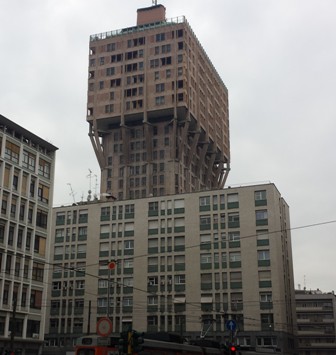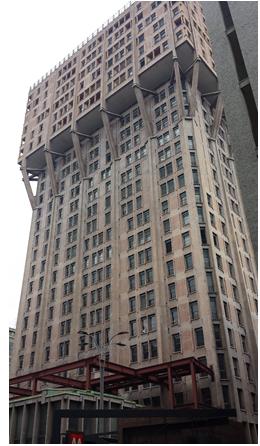The ugliest buildings in the world As in some other fields of creativity, so in architecture, in addition to the selection for the most successful and beautiful buildings, there are also selections of buildings that are the most incongruous, the ugliest and considered the biggest professional failures. Of course, this does not refer to insignificant country houses with alpine roofs and marble lions, but to construction objects that, due to their importance, location and monumentality, deserve to be on such a list.
Of course, the choice is always very subjective and often controversial, so the lists of the ugliest buildings also include some buildings that others consider masterpieces. So, for example, Orson Welles, a leading filmmaker, publicly regretted that some stray bombs in the Spanish Civil War did not destroy the Sagrada Familia church in Barcelona, which he considered the ugliest building. It seems that Mr. Welles was alone in his assessment, but the number of those who expressed a similar opinion about the Center Georges Pompidou in Paris is much higher and that building, which sharply contrasts with its romantic surroundings in the old Beaubourg district, is sometimes on the list of the world’s worst buildings, and as for all we know, many others consider it a very significant turning point in contemporary architecture. Similarly, Frank Gehry’s buildings, due to their specific appearance, are equally on the lists of the most beautiful and ugliest buildings in the world. What can we say about the building of the headquarters of China Central Television, by Rem Koolhaas, which has been very well received by the profession and won significant awards, but which is often derogatorily called “boxer shorts” by ordinary citizens of Beijing, and by some in its shape they also manage to see pornographic motifs. In general, there are a disproportionate number of Brutalist buildings on contemporary lists of the ugliest buildings, which primarily indicates the current attitude of the public towards that architectural style. It should be emphasized that significant brutalist buildings in Skopje (brutalist capital of the world) are not on those lists, for which we should thank the skill of the leading Macedonian designers during the reconstruction after the earthquake, who did well in that, then popular, architectural expression. Such an argument, however, cannot be applied to the most brutal of all Skopje Brutalist buildings, the University “Cyril and Methodius”, which, fortunately, is well hidden by vegetation, so it is difficult to notice and this saved it from ungrateful nominations. As long as the vegetation around that University is dense enough, the honor of our environment in the prestigious company of the world’s ugliest buildings will be defended only by the National Library in Pristina, whose main decorations are unusual “cauliflowers” on a flat roof.
Despite all the subjectivity and diversity of human tastes, some buildings are almost unavoidable on the lists of the ugliest buildings, such as the large pyramidal Ryugyong Hotel in Pyongyang, the Elephant building in Bangkok, which looks like an elephant, or the Longaberger Basket Company building in Ohio, which looks like basket, and among them, somewhat surprisingly, there is also an object from Italy, Milan’s Torre Velasca.
Torre Velasca When subjectivity and controversy are taken into account, choosing the ugliest building in the world is rarely more than casual fun. However, when the respected London “The Daily Telegraph” published its list of the ugliest buildings and placed Milan’s Velasca Tower in first place, in front of the Ryugyong Hotel and the Pristina Library, few of the Milanese architects were amused. From the approach to the topic, the choice of objects, expertise and applied argumentation, one could conclude that the matter is serious and that the British are not joking this time. What had always been a bit dubious had now become official, and appealing to the diversity of human tastes was no longer a convincing enough excuse.

The dumpling stuck in the throats of the proud Milanese. For God’s sake, how could it happen that a building from Caravaggio’s Milan, the city of Leonardo’s “The Last Supper”, the center of world fashion and design, a city and country that in our subconscious is the embodiment of refinement and style, is at the top of the list of the ugliest buildings?
But enough whining, let’s try to find a reasonable explanation.
After the Second World War, Italy found itself in a difficult political and economic position, but with the help of a powerful Western ally, after a few difficult years, it healed the war wounds and a significant economic rise followed. The cities in the north of the country, especially Milan, took the lead in this. During the 1950s, when it was already clear that the country had recovered and was in full swing, the need for some striking symbol of progress was felt, and for the Italians of that time (similarly to the Chinese and Arabs of today) they were, above all, skyscrapers American style. The ideal opportunity for the creation of such a symbol arose when the city authorities decided to allow the construction of a 100-meter high skyscraper on Velasca Square, in the center of Milan, on a site left empty due to wartime bombing. The design job was awarded to the established Milanese architecture firm BBPR, which seemed like the best possible choice. The owners of the company at that time were Lodovico Barbiano di Belgiojoso, Enrico Peressutti and Ernesto Nathan Rogers, all three prominent intellectuals from influential families, members of the world’s architectural elite and the most prestigious world associations, editors of well-known professional magazines and lecturers in both Italian and foreign languages universities, including the prestigious Princeton, Yale, MIT. Information about individual design contributions has not been disclosed, so we can consider them as equal authors.
Here’s how they thought. The location of the facility is in the old city center, half a kilometer from the Duomo. A skyscraper made of glass and aluminum in such a place would be an obvious visual attack on the entire city center, and it would not even fulfill the requirement that the symbol of the new Italy be typically Italian. Therefore, it was appropriate to choose a more massive construction system that would fit better into the surroundings from the 18th and 19th centuries. Also, it was judged that the shape of an ordinary square block would be uninteresting, so they tried to find some other shape that has a historical justification. The role model was at their fingertips. The shape of the towers of the Sforzesca Castello, Milan’s most important historical building, is exactly what they needed: it can be called typically Milanese and is considered visually appealing.

Of course, old buildings should not be copied literally, but they should be interpreted in a modern way, especially in terms of construction. That is why the extended floors of the newly designed Velasca tower are supported by strong concrete girders, which are a characteristic of the 20th century and show the technical superiority of our age.

All of these were completely reasonable decisions, they had their own explanation and justification, the way of thinking was academically completely correct. The result – a total fiasco.
Otherwise, the fiasco was not immediately recognized by the profession. When the building was finished, the authors even received an annual award for the best executed building in Italy. Even today, some Milanese architects do not admit failure, but speak of the building as a “protest against international architectural standards” or as “inventive architecture and the first modern mushroom building”, or as “the pride of Milan that has no intention of competing with other Italian cities in terms of renaissance”.
At least that’s what was said officially, but unofficially the authors of this facility no longer received projects of such importance, and photos of the facility did not appear where the Italian economic miracle was promoted. Fortunately, in the same year, in 1958, the Pirelli tower was completed in Milan, which fully fulfilled that task and whose authors, Gio Ponti and Pier Luigi Nervi, subsequently became world stars and received prestigious jobs, even though they were already deep into the seventh decade of life.
Later impact of the object
The failure of the Velasco Tower had a significant effect on architectural thought. The fiasco, despite the academically correct thinking, is a kind of architectural paradox and it worried the designers. What should you do when you find yourself in a similar situation?
To this day, there are those architects in Milan who play with the same idea. I don’t believe that they want to subsequently amnesty their predecessors, but they probably feel that their ideas have not been fully investigated. They believe that it is necessary to try a few more times, to correct the basic idea, and at some point it will turn out that the old masters were on the right track.

But some went the opposite way. About twenty years after the episode with the Velasca Tower, a group of designers, faced with a similar problem, solved the paradox in a radically opposite way. They were Renzo Piano, Richard Rogers and Gianfranco Franchini, designers of the Center Georges Pompidou, planned to be a center of modern art in the old Beaubourg district of Paris. They were fully aware of the failure of the Velasco Tower. Moreover, Richard Rogers is a close relative of Ernest Nathan Rogers, co-author of the Velasco Tower, and Piano and Franchini were studying architecture in Milan at the very time the tower was being completed. They knew very well what they were not allowed to do, but they were not yet sure what they were allowed to do, so they decided to do the opposite of what their esteemed predecessors would have done. They thought in a completely non-academic way and created a building that does not respect the environment at all, and they threw out all the installation pipes and ducts, otherwise unreasonably large, on the facade and painted them in different colors for water supply, air conditioning, sewage, hydrants…. The grandmothers of the neighborhood were desperate, and the newspapers wrote about the new Parisian monster. Everything, therefore, was the opposite of the first official reactions to Torre Velasco. The controversies remained to this day, but, in the long run, the building was still accepted by the citizens, and the professional public was anyway favorable from the start. However, it is better not to make any general conclusion. Let’s try to imagine that they did it in the center of Milan, in Velasco Square, on the site of the current tower. I’m not so sure they’d make it out alive.
A view from a brighter angle
I have personally seen some of the buildings that in one way or another made it onto the ugliest lists and are mentioned in this text. Let’s try to look at them from a brighter angle, especially from the point of view of the impact they have on their environment.
A quarter of a century ago, Pristina was a city of completely impersonal and uninteresting buildings. In fact, the library was the only building that even attracted attention in that sea of construction nothingness, and that, in a way, was even refreshing. The “cauliflowers” on the roof are, of course, skylights that bring much-needed diffused daylight into the reading rooms.
The China Central Television building sits in Beijing’s business district among more conservative, decently designed international skyscrapers that might as well be in Hong Kong or Atlanta or anywhere else and be completely unrecognizable. It is the television building that, with its unusual appearance, gives charm and recognition to the entire district and raises the aesthetic value of each individual object. I’m sorry to say it, but Mr. Welles is seriously wrong. The Sagrada Familia not only decorates the panorama of Barcelona, but even makes it a bit fairy-tale like.
The Center Georges Pompidou really doesn’t fit into its neighborhood. So what? There are other such districts in Paris, they have remained untouched and we can admire them as much as we want. Let’s be honest, the Beaubourg district and the buildings in it would not have been noticed if they had not been given a special charm as a contrast to this modern building.
Unfortunately, it is quite difficult to write something praiseworthy about the Velasco Tower in Milan. At the very least, it was an honorable design attempt. Maybe we could at least appreciate that.

